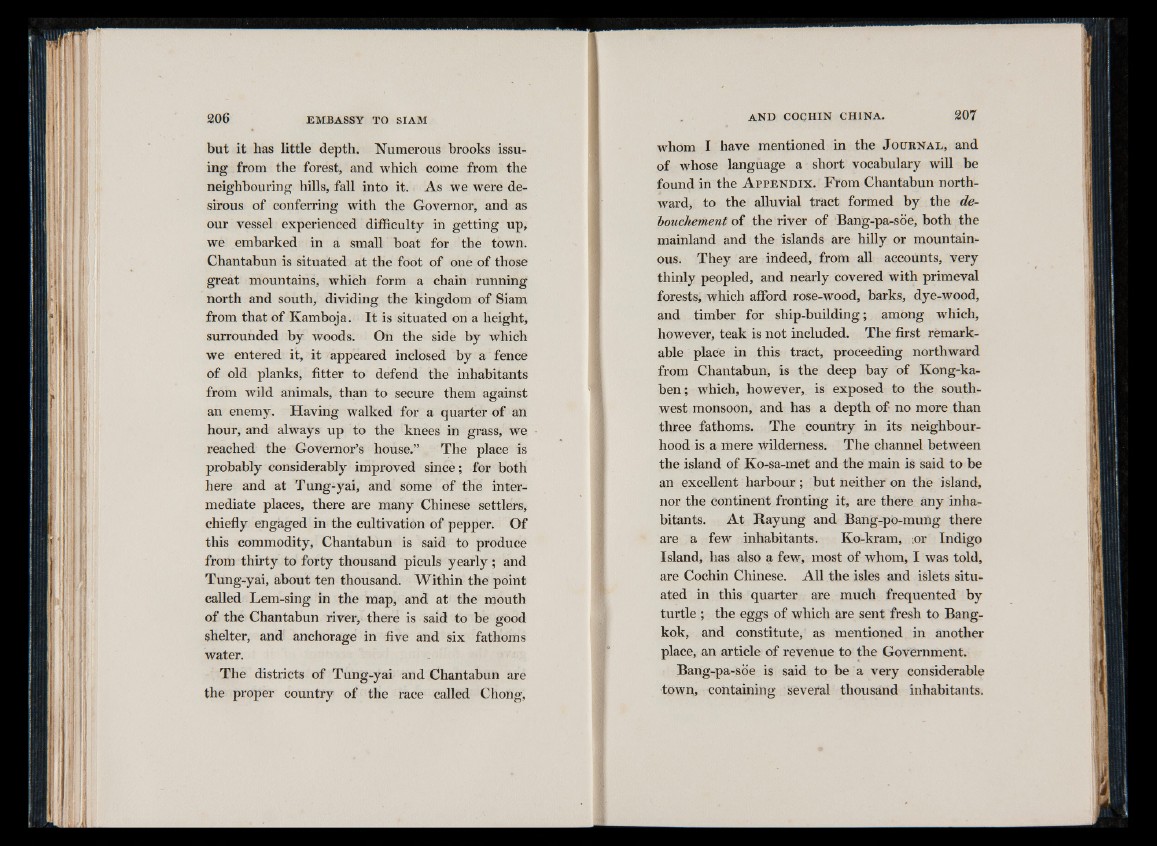
but it has little depth. Numerous brooks issuing
from the forest, and which come from the
neighbouring hills, fall into it. As we were desirous
of conferring with the Governor, and as
our vessel experienced difficulty in getting up,
we embarked in a small boat for the town.
Chantabun is situated at the foot of one of those
great mountains, which form a chain running
north and south, dividing the kingdom of Siam
from that of Kamboja. I t is situated on a height,
surrounded by woods. On the side by which
we entered it, it appeared inclosed by a fence
of old planks, fitter to defend the inhabitants
from wild animals, than to secure them against
an enemy. Having walked for a quarter of an
hour, and always up to the knees in grass, we
reached the Governor’s house.” The place is
probably considerably improved since; for both
here and at Tung-yai, and some of the intermediate
places, there are many Chinese settlers,
chiefly engaged in the cultivation of pepper. Of
this commodity, Chantabun is said to produce
from thirty to forty thousand piculs yearly ; and
Tung-yai, about ten thousand. Within the point
called Lem-sing in the map, and at the mouth
of the Chantabun river, there is said to be good
shelter, and anchorage in five and six fathoms
water.
The districts of Tung-yai and Chantabun are
the proper country of the race called Chong,
whom I have mentioned in the J o u r na l, and
of whose language a short vocabulary will be
found in the A p p e n d ix . From Chantabun northward,
to the alluvial tract formed by the de-
bouchement of the river of Bang-pa-soe, both the
mainland and the islands are hilly or mountain^
ous. They are indeed, from all accounts, very
thinly peopled, and nearly covered with primeval
forests, which afford rose-wood, barks, dye-wood,
and timber for ship-building; among which,
however, teak is not included. The first remarkable
place in this tract, proceeding northward
from Chantabun, is the deep bay of Kong-ka-
ben; which, however, is exposed to the southwest
monsoon, and has a depth of no more than
three fathoms. The country in its neighbourhood
is a mere wilderness. The channel between
the island of Ko-sa-met and the main is said to be
an excellent harbour ; but neither on the island,
nor the continent fronting it, are there any inhabitants.
A t Rayung and Bang-po-mung there
are a few inhabitants. Ko-kram, ;or Indigo
Island, has also a few, most of whom, I was told,
are Cochin Chinese. All the isles and islets situated
in this quarter are much frequented by
turtle ; the eggs of which are sent fresh to Bangkok,
and constitute, as mentioned in another
place, an article of revenue to the Government.
Bang-pa-soe is said to be a very considerable
town, containing several thousand inhabitants.